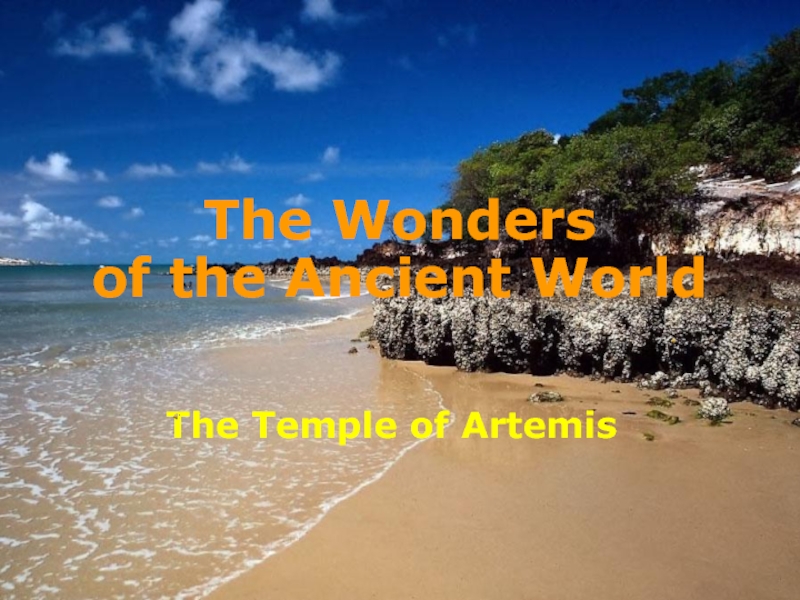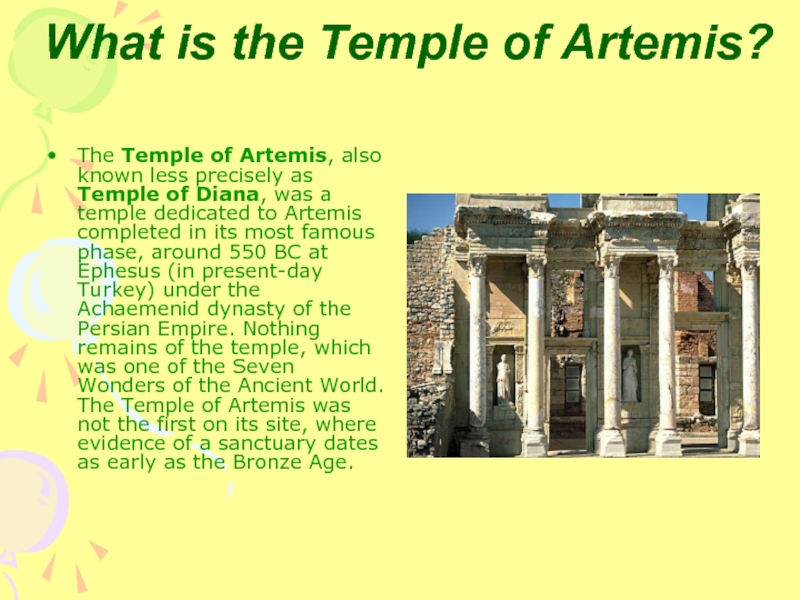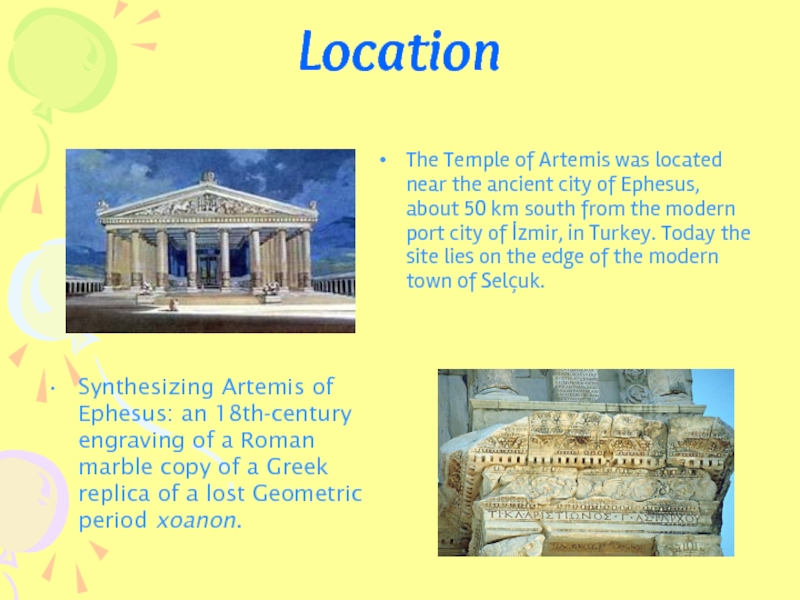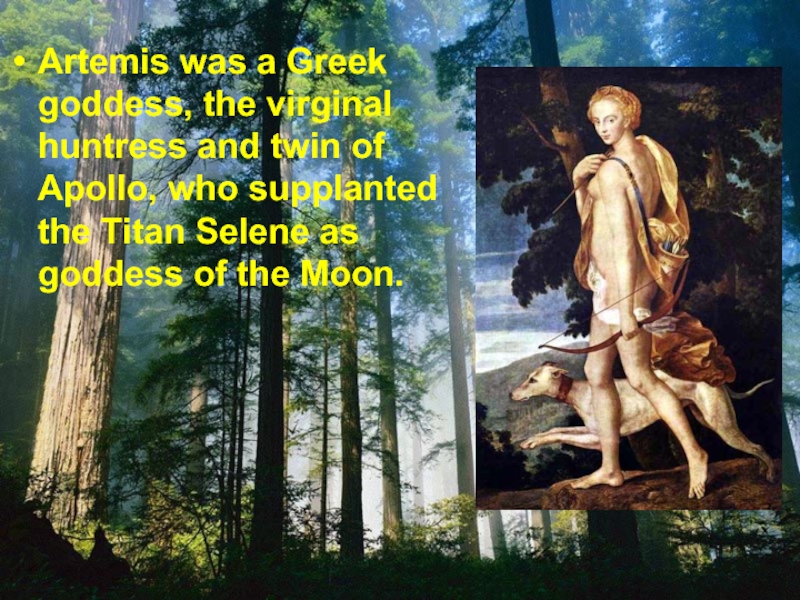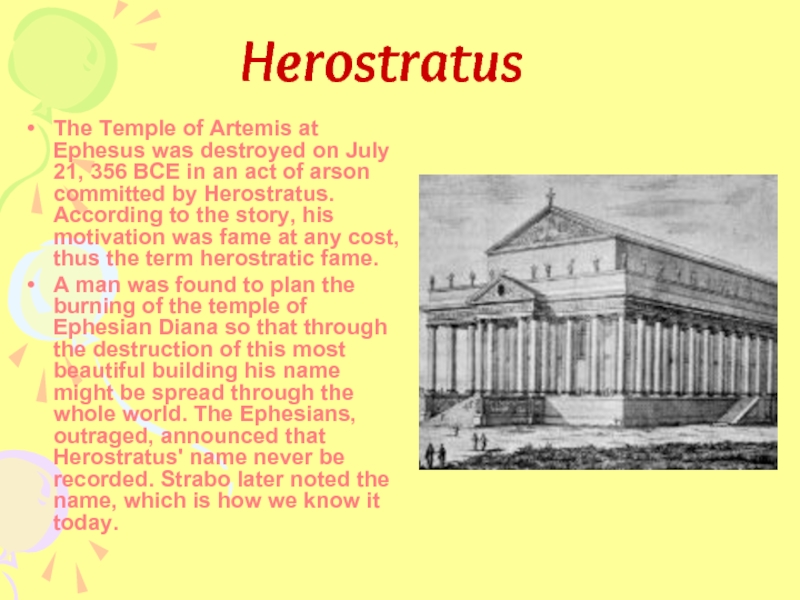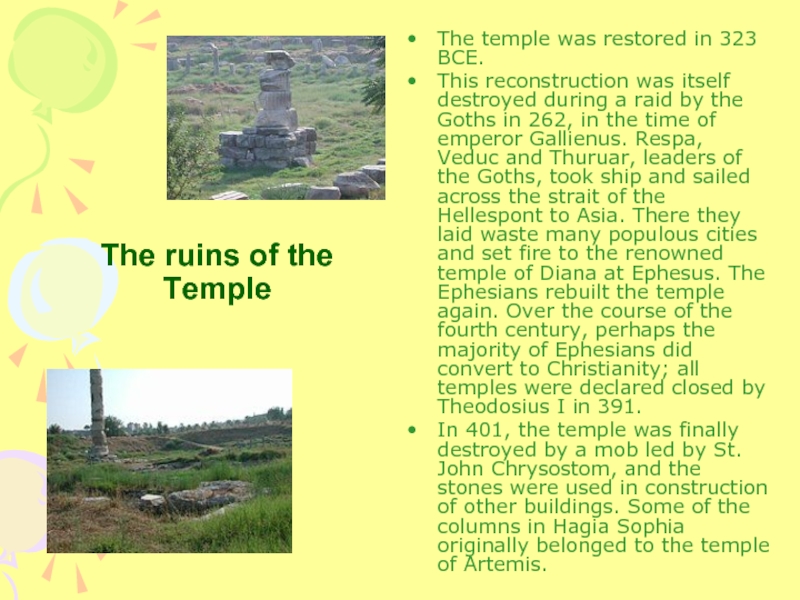Разделы презентаций
- Разное
- Английский язык
- Астрономия
- Алгебра
- Биология
- География
- Геометрия
- Детские презентации
- Информатика
- История
- Литература
- Математика
- Медицина
- Менеджмент
- Музыка
- МХК
- Немецкий язык
- ОБЖ
- Обществознание
- Окружающий мир
- Педагогика
- Русский язык
- Технология
- Физика
- Философия
- Химия
- Шаблоны, картинки для презентаций
- Экология
- Экономика
- Юриспруденция
The Wonders of the Ancient World
Содержание
- 1. The Wonders of the Ancient World
- 2. What is the Temple of Artemis?The Temple
- 3. LocationThe Temple of Artemis was located near
- 4. Artemis was a Greek goddess, the virginal
- 5. Cult and influenceThe Temple of Artemis was
- 6. Architecture and art Most of the physical
- 7. The Temple of Artemis at Ephesus was
- 8. The temple was restored in 323 BCE.This
- 9. Rediscovery After sixty years of patient searching,
- 10. Скачать презентанцию
What is the Temple of Artemis?The Temple of Artemis, also known less precisely as Temple of Diana, was a temple dedicated to Artemis completed in its most famous phase, around 550
Слайды и текст этой презентации
Слайд 3Location
The Temple of Artemis was located near the ancient city
of Ephesus, about 50 km south from the modern port city
of İzmir, in Turkey. Today the site lies on the edge of the modern town of Selçuk.Synthesizing Artemis of Ephesus: an 18th-century engraving of a Roman marble copy of a Greek replica of a lost Geometric period xoanon.
Слайд 4Artemis was a Greek goddess, the virginal huntress and twin
of Apollo, who supplanted the Titan Selene as goddess of
the Moon.Слайд 5Cult and influence
The Temple of Artemis was located at an
economically robust region, drawing merchants and travellers from all over
Asia Minor. The temple was influenced by many beliefs, and can be seen as a symbol of faith for many different peoples. The Ephesians worshiped Cybele, and incorporated many of their beliefs into the worship of Artemis. Artemisian Cybele became quite contrasted from her Roman counterpart, Diana. The cult of Artemis attracted thousands of worshipers from far-off lands.Слайд 6Architecture and art
Most of the physical description and art
within the Temple of Artemis comes from Pliny, though there
are different accounts, and the actual size varies.Pliny describes the temple as 377 feet (115 meters) long and 180 feet (55 meters) wide, made almost entirely of marble, making its area about three times as large as the Parthenon. The temple's cella was enclosed in colonnades of 127 Ionic columns, each 18 meters (60 feet) in height.
Pliny tells us that Scopas, who also worked on the Mausoleum of Mausollos, worked carved reliefs into the temple's columns. Athenagoras of Athens names Endoeus, a pupil of Daedalus, as the sculptor of the main statue of Artemis in Ephesus.
Слайд 7The Temple of Artemis at Ephesus was destroyed on July
21, 356 BCE in an act of arson committed by
Herostratus. According to the story, his motivation was fame at any cost, thus the term herostratic fame.A man was found to plan the burning of the temple of Ephesian Diana so that through the destruction of this most beautiful building his name might be spread through the whole world. The Ephesians, outraged, announced that Herostratus' name never be recorded. Strabo later noted the name, which is how we know it today.
Herostratus
Слайд 8The temple was restored in 323 BCE.
This reconstruction was itself
destroyed during a raid by the Goths in 262, in
the time of emperor Gallienus. Respa, Veduc and Thuruar, leaders of the Goths, took ship and sailed across the strait of the Hellespont to Asia. There they laid waste many populous cities and set fire to the renowned temple of Diana at Ephesus. The Ephesians rebuilt the temple again. Over the course of the fourth century, perhaps the majority of Ephesians did convert to Christianity; all temples were declared closed by Theodosius I in 391.In 401, the temple was finally destroyed by a mob led by St. John Chrysostom, and the stones were used in construction of other buildings. Some of the columns in Hagia Sophia originally belonged to the temple of Artemis.
The ruins of the Temple
Слайд 9Rediscovery
After sixty years of patient searching, the site of
the temple was rediscovered in 1869 by an expedition sponsored
by the British Museum led by John Turtle Wood;excavations continued until 1879. A few further fragments of sculpture were found during the 1904-06 excavations directed by D.G. Hogarth. The recovered sculptured fragments of the fourth-century rebuilding and a few from the earlier temple, which had been used in the rubble fill for the rebuilding, were assembled and displayed in the "Ephesus Room" of the British Museum.Today the site of the temple, which lies just outside Selçuk, is marked by a single column constructed of dissociated fragments discovered on the site.
Теги
